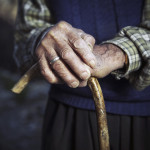People age 50 and older are nearly 2.5 times more likely to be diagnosed late with HIV than younger adults, according to a study published in the August 24 issue of AIDS. What’s more, older people who are diagnosed late are 14 times more likely to die prematurely than people who are diagnosed promptly after infection.
Researchers are increasingly concerned about the HIV epidemic in older adults. For one thing, people are living much longer—and into old age—than in the early years of the epidemic. The Centers for Disease Control and Prevention estimates that by 2015 more than half of all adults living with HIV in the United States will be older than 50. Older adults are also becoming infected and getting diagnosed with HIV at increased rates.
A study published in the July 1 issue of the Journal of Acquired Immune Deficiency Syndromes indicated that older adults respond well to antiretroviral treatment, though CD4 responses to therapy were blunted in seniors diagnosed after the age of 50—likely because they were not tested earlier and entered care only after their CD4s were abnormally low.
Additional research has been needed to verify these observations, as most resources for testing and access to care are currently targeted toward younger adults.
To determine trends in HIV infection, diagnosis and mortality in older adults, Ruth Smith, a senior scientist at the Health Protection Agency Centre for Infections in London, and her colleagues conducted an analysis of epidemiological data on all adults 15 and older who were newly diagnosed or were accessing HIV-related care between 2000 and 2007 in England, Wales and Northern Ireland.
Adults 50 and older increased from 8.3 percent in 2000 to 9.7 percent in 2007, and the absolute number of older adults diagnosed with HIV more than doubled during the period from 2000 to 2007.
Smith and her colleagues found that late diagnosis was a serious problem overall, but particularly so for older people. While 48 percent of older adults had a CD4 count less than 200 at the time of diagnosis, this was true of only 33 percent of younger adults. Among men who have sex with men, the number of older men who were diagnosed late was nearly twice that of younger men: 40 percent compared with 21 percent. Older heterosexual women were about 50 percent more likely to present late as well.
Age also played a significant role in early mortality—older adults with a late HIV diagnosis were 2.4 times as likely to die within a year of diagnoses as younger adults. Smith’s team did not have sufficient data to ascertain the reasons for the increased risk in older adults. In addition, there was a decline between 2000 and 2007 in short-term mortality among younger adults diagnosed late with HIV disease, but no decline among older adults.
Another statistic makes painfully clear the need for greater early testing efforts in people older than 50. Older adults who were diagnosed with a CD4 cell count less than 200 were 14 times more likely to die within a year of diagnosis than those diagnosed promptly (14.4 percent versus 1 percent). While this study was conducted in Great Britain, similar data have been noted in the United States.
“These findings highlight the need for increased targeted prevention efforts and HIV testing strategies among older adults to ensure earlier testing and treatment and reduce transmission of HIV,” the authors concluded. “Adults aged 50 years and over account for a significant number of persons living with HIV in developed countries, and it is important that global and national surveillance outputs include older age groups.”
Advertisement
Advertisement
Advertisement






2 Comments
2 Comments